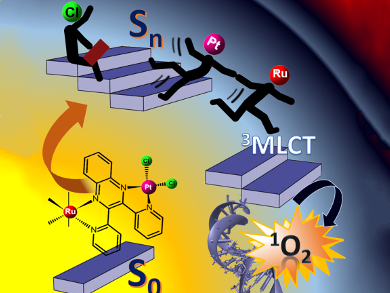Photodynamic therapy (PDT) is a minimally-invasive anti-cancer treatment with reliable tumor-ablative properties. PDT uses a photosensitizer (PS), which, upon irradiation, triggers a sequence of photochemical and photobiological processes that lead to tumor cell necrosis and/or apoptosis. This is caused by generating highly cytotoxic singlet oxygen.
Marta E. Alberto, Institut de Recherche de Chimie Paris, France, and colleagues, have developed a PDT strategy which involves the functionalization of a PS with a cisplatin-like compound. They used density functional theory (DFT) calculations to explore the properties of a RuII photosensitizer and its conjugate with a cis-PtCl2 moiety. Inspection of photoreactions and spin-orbit coupling computations reveal that the cis-PtCl2 moiety improves the photophysical properties of the RuII chromophore, ensuring efficient singlet oxygen generation and making the assembly suitable for use in photodynamic therapy.
According to the researchers, these kinds of conjugates are likely to increase the effectiveness of PDT treatment. The systems combine the effect of PDT and cytostatic activity, but also allow for better Pt-mediated distribution of the PS within the tumor, and address the drawbacks associated with traditional platinum chemotherapy.
- Synergistic Effects of Metals in a Promising RuII−PtII Assembly for a Combined Anticancer Approach: Theoretical Exploration of the Photophysical Properties,
Marta E. Alberto, Nino Russo, Carlo Adamo,
Chem. Eur. J. 2016.
DOI: 10.1002/chem.201601089




